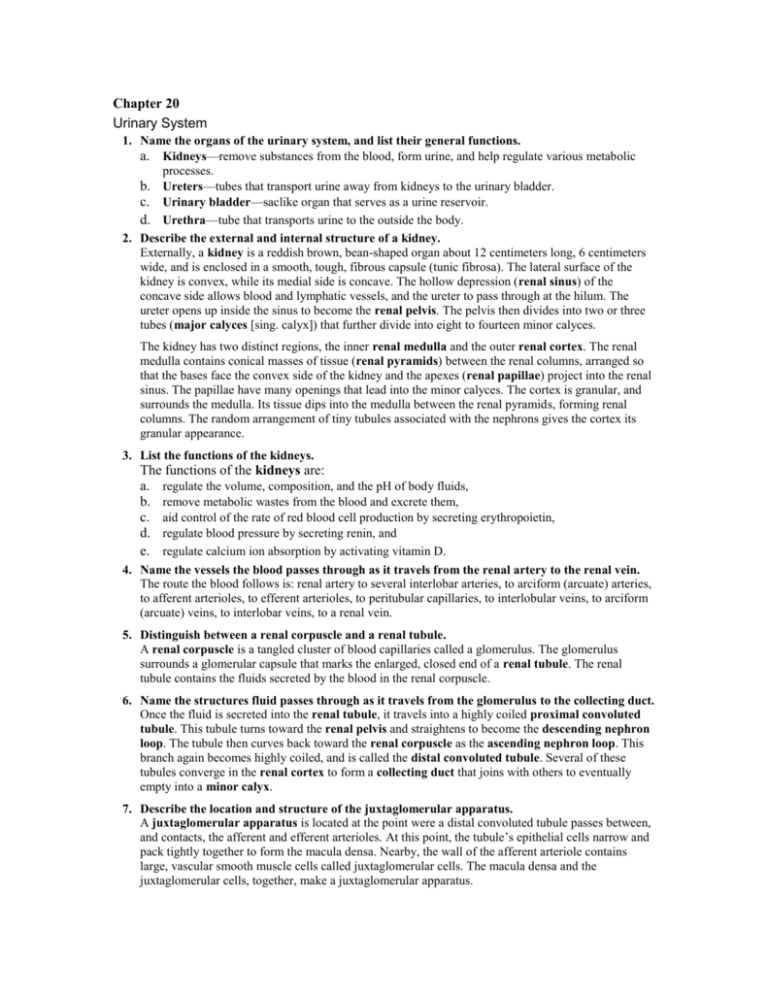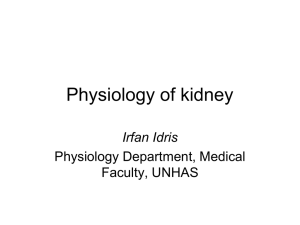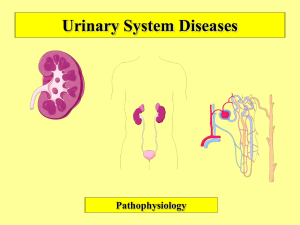Chapter 20
advertisement

Chapter 20 Urinary System 1. Name the organs of the urinary system, and list their general functions. a. Kidneys—remove substances from the blood, form urine, and help regulate various metabolic processes. b. Ureters—tubes that transport urine away from kidneys to the urinary bladder. c. Urinary bladder—saclike organ that serves as a urine reservoir. d. Urethra—tube that transports urine to the outside the body. 2. Describe the external and internal structure of a kidney. Externally, a kidney is a reddish brown, bean-shaped organ about 12 centimeters long, 6 centimeters wide, and is enclosed in a smooth, tough, fibrous capsule (tunic fibrosa). The lateral surface of the kidney is convex, while its medial side is concave. The hollow depression (renal sinus) of the concave side allows blood and lymphatic vessels, and the ureter to pass through at the hilum. The ureter opens up inside the sinus to become the renal pelvis. The pelvis then divides into two or three tubes (major calyces [sing. calyx]) that further divide into eight to fourteen minor calyces. The kidney has two distinct regions, the inner renal medulla and the outer renal cortex. The renal medulla contains conical masses of tissue (renal pyramids) between the renal columns, arranged so that the bases face the convex side of the kidney and the apexes (renal papillae) project into the renal sinus. The papillae have many openings that lead into the minor calyces. The cortex is granular, and surrounds the medulla. Its tissue dips into the medulla between the renal pyramids, forming renal columns. The random arrangement of tiny tubules associated with the nephrons gives the cortex its granular appearance. 3. List the functions of the kidneys. The functions of the kidneys are: a. regulate the volume, composition, and the pH of body fluids, b. remove metabolic wastes from the blood and excrete them, c. aid control of the rate of red blood cell production by secreting erythropoietin, d. regulate blood pressure by secreting renin, and e. regulate calcium ion absorption by activating vitamin D. 4. Name the vessels the blood passes through as it travels from the renal artery to the renal vein. The route the blood follows is: renal artery to several interlobar arteries, to arciform (arcuate) arteries, to afferent arterioles, to efferent arterioles, to peritubular capillaries, to interlobular veins, to arciform (arcuate) veins, to interlobar veins, to a renal vein. 5. Distinguish between a renal corpuscle and a renal tubule. A renal corpuscle is a tangled cluster of blood capillaries called a glomerulus. The glomerulus surrounds a glomerular capsule that marks the enlarged, closed end of a renal tubule. The renal tubule contains the fluids secreted by the blood in the renal corpuscle. 6. Name the structures fluid passes through as it travels from the glomerulus to the collecting duct. Once the fluid is secreted into the renal tubule, it travels into a highly coiled proximal convoluted tubule. This tubule turns toward the renal pelvis and straightens to become the descending nephron loop. The tubule then curves back toward the renal corpuscle as the ascending nephron loop. This branch again becomes highly coiled, and is called the distal convoluted tubule. Several of these tubules converge in the renal cortex to form a collecting duct that joins with others to eventually empty into a minor calyx. 7. Describe the location and structure of the juxtaglomerular apparatus. A juxtaglomerular apparatus is located at the point were a distal convoluted tubule passes between, and contacts, the afferent and efferent arterioles. At this point, the tubule’s epithelial cells narrow and pack tightly together to form the macula densa. Nearby, the wall of the afferent arteriole contains large, vascular smooth muscle cells called juxtaglomerular cells. The macula densa and the juxtaglomerular cells, together, make a juxtaglomerular apparatus. 8. Distinguish between cortical and juxtamedullary nephrons. Nephrons located in the renal cortex are called cortical nephrons. The nephrons located close to the renal medulla have nephron loops extending into the medulla, and are thus called juxtamedullary nephrons. 9. Distinguish among filtration, reabsorption, and secretion as they relate to urine formation. Filtration moves chemicals from the glomerulus into the renal tubules by pressure. Reabsorption moves some of these chemicals back into the blood. Secretion moves other chemicals from the peritubular capillaries into renal tubules by various mechanisms. 10. Define filtration pressure. Filtration pressure is the net pressure that causes substances to move from the capillaries into the renal tubules. The calculation takes into account glomerular hydrostatic pressure (blood pressure inside the glomerulus), capsular hydrostatic pressure (fluid pressure inside the glomerular capsule), and the glomerular osmotic pressure (the amount of force the substances have in the blood to keep water inside). 11. Compare the composition of glomerular filtrate with that of the blood plasma. The glomerular filtrate has about the same composition as what becomes tissue fluid elsewhere in the body. In other words, glomerular filtrate is mostly water and contains essentially the same substances as blood plasma, except for the larger protein molecules. 12. Explain how the diameters of the afferent and efferent arterioles affect the rate of glomerular filtration. The rate of glomerular filtration is directly proportional to the filtration pressure. So, if the afferent arteriole constricts, blood flow decreases, and the filtration pressure drops. On the other hand, if the efferent arteriole constricts, the resulting back pressure will cause an increase in filtration pressure. 13. Explain how changes in the osmotic pressure of the blood plasma may affect glomerular filtration. Osmotic pressure is the amount of attraction of substances to water. When hydrostatic pressure forces water out, the remaining blood proteins exert more force to pull water back in. When the osmotic pressure is high enough, filtration stops. If blood protein concentration is low, filtration increases. If the blood flow is rapid, osmotic pressure stays low and filtration rates remain high. If the blood flow is slow, the osmotic pressure changes because the blood has more time to be filtered. 14. Explain how the hydrostatic pressure of a glomerular capsule affects the rate of glomerular filtration. The hydrostatic pressure in the glomerular capsule opposes the hydrostatic pressure in the glomerulus. If the glomerular capsule pressure is too great, as with an obstruction, filtration will decrease. 15. Describe two mechanisms by which the body regulates the filtration rate. Glomerular filtration rate (GFR) can be controlled by the renin-angiotensin system, which controls sodium excretion. Renal baroreceptors sense changes in blood pressure and act with the sympathetic nervous system to cause the juxtaglomerular cells to secrete renin when the pressure drops. The macula densa sense concentrations of sodium, potassium, and chlorid ions and causes renin secretion if any of these drop too low. The atrial natriuretic hormone (ANH) can also control GFR. When the atria stretch because of excessive pressure. This process is called autoregulation. 16. Define autoregulation. Filtration usually, and continuously, occurs simply by the physical properties of osmosis and hydrostatic pressure. This process is called autoregulation. 17. Discuss how tubular reabsorption is a selective process. Tubular reabsorption causes the composition of the filtrate to change before it is excreted as urine. For instance, glucose is present in the filtrate, but is absent in the urine. Urea and uric acid are considerably more concentrated in the urine than they are in the glomerular filtrate. This is accomplished through the epithelium of the renal tubule. 18. Explain how the peritubular capillary is adapted for reabsorption. Because the efferent arteriole is narrower than the peritubular capillary, the pressure of the blood in the capillary is relatively low. Also, the walls of the capillary are more permeable than those of other capillaries. These factors enhance the rate of fluid reabsorption. 19. Explain how epithelial cells of the proximal convoluted tubule are adapted for reabsorption. The epithelial of the proximal convoluted tubule contain microvilli that greatly increase their surface area. For this reason, most tubular reabsorption occurs here. 20. Explain why active transport mechanisms have limited transport capacities. Active transport is a highly selective mechanism. The carrier molecules can only transport certain amounts of very specific passenger molecules. For this reason, the active transport mechanism has a limited transport capacity. 21. Define renal plasma threshold, and explain its significance in tubular reabsorption. Under normal conditions there are sufficient carrier molecules to transport glucose out of the filtrate. If the glucose concentration reaches a point where active transport can no longer handle it, it is said to have reached its renal plasma threshold. Because no more glucose can be carried out, the excess will remain in the urine. This is significant because glucose draws water into the renal tubule by osmosis and results in increased urine volume. 22. Explain how amino acids and proteins are reabsorbed. Amino acids are thought to be reabsorbed by using three different active transport systems in the proximal convoluted tubules. Each active transport system reabsorbs a different group of amino acids with a similar molecular structure. The filtrate is usually free of proteins except albumin. Albumin has a relatively small structure and is reabsorbed by pinocytosis in the microvilli of the proximal convoluted tubules. From there, it is converted by enzymatic actions into amino acids and moved back into the blood of the peritubular capillaries. 23. Describe the effect of sodium reabsorption on the reabsorption of negatively charged ions. Because sodium is a positively charged ion, its reabsorption causes negatively charged ions to follow it out of the filtrate. The sodium is reabsorbed by active transport in the proximal area of the renal tubule. The negatively charged ions of chloride, phosphate, and bicarbonate follow through in passive transport systems. 24. Explain how sodium ion reabsorption affects water reabsorption. As sodium and its negative ions are reabsorbed, the solute concentration of the peritubular capillaries increases. This causes water to move into the peritubular capillary by osmosis in order to equalize the solute concentrations on both sides, and this reduces the fluid volume within the renal tubule. 25. Explain how hypotonic tubular fluid is produced in the ascending limb of the nephron loop. The ascending limb of the nephron loop is impermeable to water but diffuses electrolytes by transport mechanisms. This causes its fluid to be hypotonic with respect to the interstitial fluid surrounding it. 26. Explain why fluid in the descending limb of the nephron is hypertonic. Because the descending limb of the nephron loop is very permeable to water yet almost impermeable to solutes, its fluid is hypertonic with respect to the interstitial fluid surrounding it. 27. Describe the function of ADH. ADH (antidiuretic hormone), produced by the hypothalamus and secreted by the posterior lobe of the pituitary gland, causes water reabsorption to increase by increasing the permeability of the linings of the distal convoluted tubules and collecting ducts. This occurs in response to decreasing blood volume and pressure or decreasing concentrations of water in the blood. 28. Explain how the renal tubule is adapted to secrete hydrogen ions. Secretory mechanisms are active transport mechanisms that work in the opposite direction. The epithelium of the proximal convoluted segment actively secretes hydrogen ions along with other organic compounds. 29. Explain how potassium ions may be secreted passively. The active reabsorption of sodium ions out of the tubular fluid produces a negative charge within the tube. Because of this, in the distal portions of the proximal convoluted tubule and the collecting duct, potassium ions (which are positively charged) move from the tubular epithelium and into the tubular fluid by electrical attraction. 30. Explain how urine may become concentrated as it moves through the collecting duct. In response to certain metabolic conditions such as decreasing blood or fluid volume, the posterior lobe of the pituitary gland releases ADH (antidiuretic hormone). In the kidney, ADH causes increased permeability of the epithelial linings of the distal convoluted tubule and collecting duct. This moves water rapidly out of these segments. Thus, the urine becomes more concentrated because water is conserved by the body. 31. Compare the processes by which urea and uric acid are reabsorbed. About fifty percent of urea is reabsorbed by passive diffusion in the renal tubule. The rest is secreted in the urine. Uric acid is reabsorbed by active transport. Although all of the uric acid is reabsorbed, about ten percent is secreted in the urine. This seems to be a result of the acid being secreted back into the renal tubule. 32. List the more common substances found in urine and their sources. a. Water—excess intake and cellular metabolism. b. Urea—a by-product of amino acid catabolism. c. Uric acid—a by-product of organic base and nucleic acid metabolism. d. Amino acids--protein synthesis or breakdown. e. Electrolytes--various body processes. 33. List some of the factors that affect the volume of urine produced each day. These factors include: amount of fluid intake, environmental temperature, relative humidity of surrounding air, the person's emotional condition, respiratory rate, and body temperature. 34. Describe the structure and function of a ureter. A ureter is a tubular organ, approximately 25 centimeters long. It begins as the funnel-shaped renal pelvis, extends downward behind the parietal peritoneum and parallel to the vertebral column. In the pelvic cavity, it moves medially and anteriorly, to join the urinary bladder from underneath. The wall of the ureter has three layers: a. Mucous coat—the inner layer, it is continuous with the linings of the renal tubules and the urinary bladder. b. Muscular coat—the middle layer consisting largely of smooth muscle. c. Fibrous coat—the outer layer, it consists of connective tissue. The ureter functions to pass urine from the kidneys into the urinary bladder. 35. Explain how the muscular wall of the ureter aids in moving urine. The smooth muscle layer produces peristaltic waves originating from the renal pelvis and forcing urine along the ureter into the urinary bladder. 36. Discuss what happens if a ureter becomes obstructed. If the ureter becomes obstructed, peristaltic waves strengthen at the proximal end of the tube helping to push the obstruction into the bladder. Concurrently, the ureterorenal reflex constricts the renal arterioles and decrease urine production in that kidney. 37. Describe the structure and location of the urinary bladder. The urinary bladder is a hollow, distensible, muscular organ located within the pelvic cavity, just posterior to the symphysis pubis, and inferior to the parietal peritoneum. It is somewhat spherical in shape and when empty, contains many folds. Internally, the floor of the bladder contains a triangular area called the trigone that has openings at each of the three points. At the base of the trigone, are the openings for the ureters, and anteriorly, the bladder has a short, funnel shaped extension called the neck of the bladder that contains the opening to the urethra. The bladder wall consists of four layers: a. Mucous coat—the innermost layer, it contains several layers of transitional epithelial cells. b. Submucous coat—the second layer, it consists of connective tissue and elastic fibers. c. Muscular coat—this layer contains coarse bundles of smooth muscle fiber. Together these muscles comprise the detrusor muscle. d. Serous coat—the outermost layer, it is synonymous with the parietal peritoneum. This layer occurs only on the upper surface of the bladder. Elsewhere, the outer coat is comprised of fibrous connective tissue. 38. Define detrusor muscle. The detrusor muscle is the muscle layer of the bladder. Part of this muscle surrounds the neck of the bladder and forms the internal urethral sphincter. The sustained contraction of this muscle prevents urine from passing into the urethra until the pressure within the bladder reaches a certain level. 39. Distinguish between the internal and external urethral sphincters. The internal urethra sphincter is composed of smooth muscle that surrounds the neck of the bladder. It is controlled involuntarily. The external urethral sphincter is part of the urogenital diaphragm and is located about three centimeters below the bladder and surrounding the urethra. It is composed of skeletal muscle tissue and is therefore controlled voluntarily. 40. Compare the urethra of a female with that of a male. Structurally, urethras in both males and females are internally lined with a mucous membrane containing numerous mucous glands (urethral glands) and are surrounded by a thick layer of longitudinal smooth muscle fibers. The female urethra is about 4 cm long and travels forward from the bladder, below the symphysis pubis, and empties from the external urethra orifice (urinary meatus)—anterior to the vaginal opening and 2.5 cm posterior to the clitoris. In the male, the urethra functions as a urinary canal and a passageway for secretions and cells of the reproductive organs. It contains three sections: a. Prostatic urethra—about 2.5 cm long, it passes from the bladder through the prostate gland. Ducts from the reproductive structures empty here. b. Membranous urethra—about 2 cm long, it begins just distal to the prostate gland passing through the urogenital diaphragm. It is surrounded by fibers of the external urethral sphincter muscle. c. Penile urethra—about 15 cm long, it passes through the corpus spongiosum of the penis ends at the tip of the penis with the external urethral orifice. 41. Describe the micturition reflex. The micturition reflex (urination) involves the contraction of the detrusor muscle and relaxation of the external urethral sphincter. When the bladder is sufficiently distended with urine, stretch receptors in the wall of the bladder signal the micturition reflex center in the spinal cord to send a motor impulse along the parasympathetic nerves to the detrusor muscle. 42. Explain how the micturition reflex can be voluntarily controlled. Because the external urethral sphincter is composed of skeletal muscle, its contraction and relaxation can be consciously controlled until the decision to urinate is made. This control is aided by nerve centers in the brain stem and cerebral cortex that can partially inhibit the micturition reflex. Nerve centers within the pons and hypothalamus function to make the micturition reflex more effective. 43. What changes occur in the urinary system with age? The kidneys are slower to remove nitrogenous wastes and toxins and to compensate for changes to maintain homoestasis. From the outside, the kidneys change with age, appearing scarred and grainy as arterioles serving the cortex constrict, and fibrous connective tissue accumulates around the capsules. On the inside, kidney cells begin to die as early as age 20 years, but the gradual shrinkage is not generally noticeable until after age 40. By 80 years, the kidneys have lost about a third of their mass. Further along the nephron, the renal tubules thicken, accumulating coats of fat. The bladder, ureters, and urethra change with the years too. These muscular organs lose elasticity and recoil with age, so that in the later years, the bladder holds less than half of what it did in young adulthood, and may retain more urine after urination. In the elderly, the urge to urinate may become delayed, so that when it does happen, it is sudden. Older individuals have to urinate at night more than younger people.









